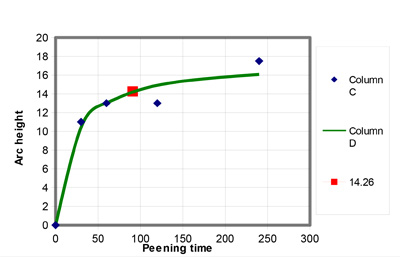Could your parts be improved by shot peening? Probably so, read on;
The wonderful process of shot peening that imparts its invisible magical force onto the surface of metal objects to greatly extend their life. It keeps planes in the sky, by preventing turbine blade failures, and lets your car springs pass over millions of bumps without snapping. Turbines, engines and aircraft are all full of hidden shot peened parts, although it is still an under utilized manufacturing process.
Higher strength parts, using less material and weighing less are a manufacturers dream.
If you manufacture or repair components or structures from any metal material, there is a good chance shot peening can enhance the quality and performance of the part.
If the parts you produce or repair are made from metal, and are subjected to cyclic stress loadings and fatigue failures, there is a high probability shot peening will greatly improve their performance.
The surface of all metal parts contains minute surface defects, blemishes, microcracks and high stress areas, induced into the part from the manufacturing and machining process. When a metal part is stressed and subjected to cyclic loading these surface defects enlarge and form cracks that propagate through the part until it ultimately fails.
Shot peening is a cold working process applied to the surface of metal parts to increase their resistance to fatigue failure, stress corrosion cracking, galling and fretting. Shot peening will also increase the components load carrying capacity.
The process involves bombarding the surface of the part with a high velocity stream of peening media particles. These are tiny balls manufactured from steel, glass or ceramic that are as hard as, or harder than, the surface being peened. As each particle strikes the surface, it produces a tiny round dimple and causes plastic deformation of the surface.
When complete peening coverage is achieved, the plastic deformation of the surface forms a layer of compressive stress which will counter any tensile stresses near the surface and prevent any cracks from enlarging. As part failure is caused by the enlargement of surface cracks, preventing their propagation improves the service life of the component many fold.
Some examples of how shot peening can benefit your operation as follows:
Fatigue life improvement. Turbine blades, drilling equipment, leaf and coils springs, drive shafts, gears, compressor blades, steering components, etc; all are subjected to continuous repetitive cyclic loadings. Operating under these conditions the parts are exposed to 100,000’s if not millions of cycles. Eventually the metal tires out and fails. Shot peening the part prior to service can extend its life many times over.
Stress corrosion cracking reduction. SCC occurs to components, or structures, subjected to the simultaneous interaction of a corrosive environment and a sustained tensile stress, applied or residual. Both conditions must be present for stress corrosion cracking to occur. Shot peening applies a layer of compressive stress to the parts surface. The absence of surface tensile stresses eliminates one of the required conditions and thus prevents SCC from occurring. Stress corrosion cracking will not occur in an area of compressive stress.
Galling prevention. Strong adhesive forces between 2 mating metal surfaces can cause galling to occur, screw threads are particularly susceptible to galling. Tiny metal particles detach from one of the surfaces and cause seizure of the part. Shot peening the parts cold works the surfaces and reduces the likelihood of galling occurring.
Surface hardening. Some parts cannot be heat treated, but require wear resistance on one or more of the surfaces. Controlled shot peening can work harden the surface of many materials including; inconel, stainless steels, aluminium, stellite, brass, manganese stainless steel and hastelloy. Shot peening can increase the surface hardness by up to 250%.
Metal coating densifying. Plasma and metal spray coatings can be shot peened to densify the coating. Shot peening will also close porosity on the surface. The fatigue limit of sintered metals can also be increased significantly by surface densification from shot peening.
Weld failure. The process of welding induces considerable residual stress into the part. The heat affected zone is most susceptible to failure. Shot peening of the weld and heat affected zone will reverse the residual stress from tensile to compressive. The shot peening will greatly reduce the chance of crack initiation in the heat affected zone.
Threads. The fatigue resistance of threads is greatly reduced due to high concentrations of stresses at the thread root. Shot peening thread roots and thread relief areas will restore fatigue resistance and reduce susceptibility to stress corrosion cracking.
The above is a small illustration of the benefits that can be achieved from shot peening. If you manufacture or repair components or structures from any metal material, there is a good chance shot peening can enhance the quality and performance of the part.

